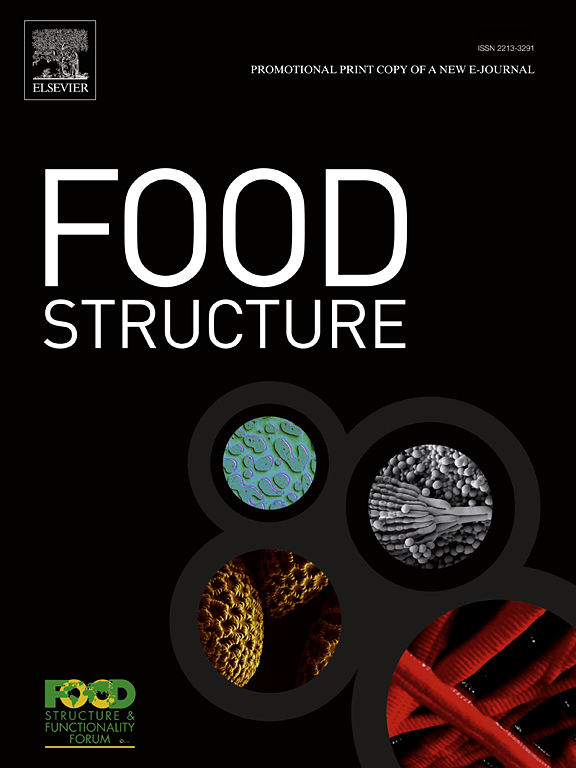淀粉辅助膨化花生蛋白孔结构的变化及其对结构和复水性能的影响
IF 5.9
3区 农林科学
Q1 FOOD SCIENCE & TECHNOLOGY
引用次数: 0
摘要
挤压重组植物蛋白食品有利于环境的可持续性。花生蛋白是一种高质量的植物蛋白来源,可以用于实现这一目标。然而,在挤压过程中孔隙结构的控制是具有挑战性的,导致较差的质地和复水性能。在这项研究中,花生蛋白和豌豆淀粉的共混物在豌豆淀粉的掺入量为0 %,10 %,15 %,20 %,25 %和30 % (w/w)的情况下进行挤压加工,以制造具有多孔结构的挤出物。结果表明:随着豌豆淀粉含量的增加,花生蛋白挤出物的膨胀比由1.47提高到2.80,气孔增大;这促进了挤出物更快的吸水。蛋白质和淀粉通过氢键和疏水相互作用相互作用,影响二硫键和游离巯基。较高的豌豆淀粉含量增加了蛋白质与淀粉的相互作用,导致聚合物体系具有较高的粘度。研究结果说明了花生蛋白和豌豆淀粉的多孔结构对挤出物结构和再水化性能的影响。本文章由计算机程序翻译,如有差异,请以英文原文为准。
Changes in starch-assisted expansion porous structure of peanut protein via extrusion and impact on textural and rehydration properties
Extruded restructured plant proteins for foods are beneficial towards environmental sustainability. Peanut protein is a high-quality source of plant protein that can be utilized towards this goal. However, control of pore structure during extrusion is challenging, leading to poor texture and rehydration properties. In this study, blends of peanut protein and pea starch were subjected to extrusion processing at pea starch inclusion levels of 0 %, 10 %, 15 %, 20 %, 25 %, and 30 % (w/w) to fabricate extrudates possessing a porous structure. Results showed that increased pea starch content raised the expansion ratio of the peanut protein extrudates from 1.47 to 2.80, creating larger pores. This promoted faster water absorption by the extrudates. Protein and starch interacted through hydrogen bonds and hydrophobic interactions, influencing disulfide bonds and free sulfhydryl groups. Higher pea starch content increased protein-starch interactions, resulting in polymer systems with higher viscosity. The results explained the influence of the porous structure of peanut protein and pea starch on the extrudate’s textural and rehydration properties during extrusion.
求助全文
通过发布文献求助,成功后即可免费获取论文全文。
去求助
来源期刊

Food Structure-Netherlands
Chemical Engineering-Bioengineering
CiteScore
7.20
自引率
0.00%
发文量
48
期刊介绍:
Food Structure is the premier international forum devoted to the publication of high-quality original research on food structure. The focus of this journal is on food structure in the context of its relationship with molecular composition, processing and macroscopic properties (e.g., shelf stability, sensory properties, etc.). Manuscripts that only report qualitative findings and micrographs and that lack sound hypothesis-driven, quantitative structure-function research are not accepted. Significance of the research findings for the food science community and/or industry must also be highlighted.
 求助内容:
求助内容: 应助结果提醒方式:
应助结果提醒方式:


